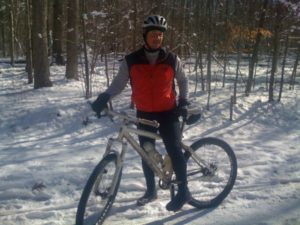
Teased into resuming your outdoor workouts by our recent three-day run of temperatures in the 70s? Even though the temperature isn’t supposed to get much above 45 today, that doesn’t mean you have to revert to your troglodyte was of suffering through another session on your basement trainer, or sweating to the oldies with little Richard. You may have to keep your shorts and T-shirts in the closet, but observe a few easy rules of cold weather outdoor engagement and the outdoors can be your playground on all but the coldest of days. Which is a good place to start.
How cold is too cold? We put that question to Hope Choplin, a fitness specialist with WakeMed’s Healthworks program and her answer was encouraging, at least for folks living in balmy Zone 8 of the USDA’s gardening hardiness estimations.
“It is safe for most people to exercise outside if the air temperature, including the wind chill, is greater than -25 degrees,” says Choplin. Older folks and those with respiratory and heart issues should be more observant of cold temperatures, but even then, she says, they should be good down to -5 F.
Runners and other heavy breathers (when it comes to exercise) should be more cautious in the cold. But generally because of their increased lung capacity and better overall condition, they should be good.
Warm up to warming up. Warming up is even more important in the cold, says Choplin. “The warm-up is always a crucial part of the workout, but this is especially true in cold weather.”
“Your blood goes from your extremities to your heart and core, to keep your vital organs warm,” she explains. “Using your large muscle groups — your arms, your legs legs — gets your heart rate up and your blood out to muscles.”
Also, it’s best to warm up inside, in the warmth, before heading out.
What to wear, what to wear? “Avoid overdressing,” advises Choplin. “Our bodies produce heat during exercise and can overheat if too much is worn.” Which raises the question of which is better: Dress your core lightly but wear gloves and a hat, or wear tights and a long-sleeve fleece? Either works, she says: “We lose heat evenly throughout our body.” And, as expected, Choplin is an advocate of layering. “Wear two to three layers, including a thin inner layer that will wick the sweat away from your body, a lightweight second layer and, if you need it, a heavier outer layer. If it’s wet out, make sure that outer layer is waterproof or water repellant to keep you dry.”
There is no one-size-fits-all advise when it comes to layering, she says. “You just have to experiment and see what works for you.”
Shorten your workout (at least initially). Your body needs to adjust to the cold, so ease into your cold weather workouts. “Go our for a little less time than normal and plan to stay closer to home.”
Feel the caloric burrrrrrn. One advantage to a cold weather workout: Not only is your body burning calories to keep you moving, it’s burning calories to keep you warm. Thus, you might want to fuel up a little more than usual before a cold weather workout. “Eat a snack before heading out,” Choplin advises. “Maybe something with a little peanut butter.”
Slow down. A cold weather workout can be more stressful on your body. “Slow your pace,” advises, Choplin. “Exercise less intensely.”
Look at your cold weather workout as a bonus, she suggests. If you have to cut it short, if you have to scale it back it’s not a big deal. Injuring yourself as a result of the cold, on the other hand, can be.
“Listen to your body,” she adds. “If something doesn’t feel right, pay attention.”